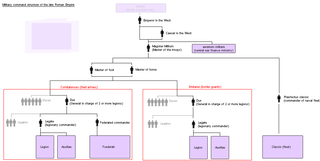 W
WMagister militum was a top-level military command used in the later Roman Empire, dating from the reign of Constantine the Great. The term referred to the senior military officer of the Empire. In Greek sources, the term is translated either as strategos or as stratelates.
 W
WFlavius Aetius was a Roman general of the closing period of the Western Roman Empire. He was a military commander and the most influential man in the Western Roman Empire for two decades (433–454). He managed policy in regard to the attacks of barbarian federates settled throughout the Western Roman Empire. Notably, he mustered a large Roman and allied (foederati) army in the Battle of the Catalaunian Plains, ending the Huns' devastating invasion, led by Attila in 451, though another devastating invasion of the Huns occurred in the year after that, resulting in the Sack of Aquileia.
 W
WProcopius Anthemius was western Roman emperor from 467 to 472.
 W
WArdabur served as magister militum in the East Roman army in the 420s, under Theodosius II. He was of Alanic origin.
 W
WFlavius Areobindus Dagalaifus Areobindus was an East Roman (Byzantine) general and politician. The scion of a distinguished line, he led troops in the Anastasian War, and served as consul in 506. During an urban riot in 512, he was proclaimed emperor by the mob, but he had gone into hiding. He died soon after.
 W
WFlavius Ardabur Aspar was an Eastern Roman patrician and magister militum of Alanic-Gothic descent. As the general of a Germanic army in Roman service, Aspar exerted great influence on the Eastern Roman Emperors for half a century, from the 420s to his death in 471, over Theodosius II, Marcian and Leo I, who, in the end, had him killed. His death led to the ending of the Germanic domination of Eastern Roman policy.
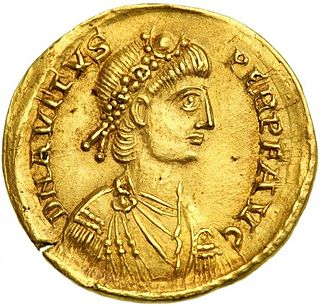 W
WEparchius Avitus was Roman emperor of the West from July 455 to October 456. He was a senator of Gallic extraction and a high-ranking officer both in the civil and military administration, as well as Bishop of Piacenza.
 W
WFlavius Belisarius was a military commander of the Byzantine Empire. He was instrumental in the reconquest of much of the Mediterranean territory belonging to the former Western Roman Empire, which had been lost less than a century prior.
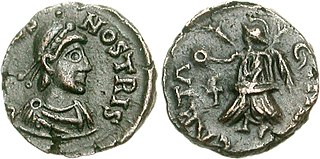 W
WBonifatius was a Roman general and governor of the diocese of Africa. He campaigned against the Visigoths in Gaul and the Vandals in north Africa. An ally of Galla Placidia, mother and advisor of Valentinian III, Bonifacius engaged in Roman civil wars on her behalf against the generals Felix in 427-429 and Aetius in 432. Although he defeated the latter at the Battle of Rimini, Bonifacius suffered a fatal wound and was succeeded by his son-in-law Sebastianus as patricius of the Western Roman Empire.
 W
WChilderic I was a Frankish leader in the northern part of imperial Roman Gaul and a member of the Merovingian dynasty, described as a king, both on his Roman-style seal ring, which was buried with him, and in fragmentary later records of his life. He was father of Clovis I, who acquired effective control over all or most Frankish kingdoms, and a significant part of Roman Gaul.
 W
WConstantius III was Roman emperor of the West in 421, from 8 February until his death on 2 September. He earned his position as Emperor due to his capability as a general under Honorius, achieving the rank of Magister militum by 411. That same year, he was sent to suppress the revolt of Constantine III, a Roman general who declared himself emperor. Constantius led his army to Arles in Gaul, the capital of Constantine III, and defeated Gerontius, a general rebelling against Constantine, before himself besieging Arles. After defeating a relief force led by Edobichus, Constantius convinced Constantine to surrender, promising safe retirement, but betrayed and beheaded him as soon as he surrendered. Constantius then went on to lead campaigns against various barbarian groups in Hispania and Gaul, recovering much of both for the Western Roman Empire. Constantius was proclaimed Western Roman Emperor by Honorius on 8 February 421. He reigned for seven months before dying on 2 September 421.
 W
WFlavius Felix was a general of the Western Roman Empire, who reached the prominent rank of patrician before being killed probably by order of Flavius Aetius. For his consulate, in 428, he issued some consular diptychs, one of which has been preserved until modern times.
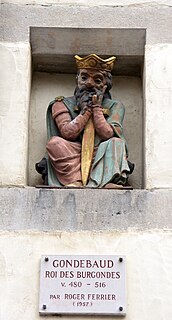 W
WGundobad was King of the Burgundians, succeeding his father Gundioc of Burgundy. Previous to this, he had been a Patrician of the moribund Western Roman Empire in 472 – 473, three years before its collapse, succeeding his uncle Ricimer. He is perhaps best known today as the probable issuer of the Lex Burgundionum legal codes, which synthesized Roman law with ancient Germanic customs. He was the husband of Caretene.
 W
WHeraclius the Elder was a Byzantine general and the father of Byzantine emperor Heraclius. Of possible Armenian origin, Heraclius the Elder distinguished himself in the war against the Sassanid Persians in the 580s. As a subordinate general, Heraclius served under the command of Philippicus during the Battle of Solachon and possibly served under Comentiolus during the Battle of Sisarbanon. In circa 595, Heraclius the Elder is mentioned as a magister militum per Armeniam sent by Emperor Maurice to quell an Armenian rebellion led by Samuel Vahewuni and Atat Khorkhoruni. In circa 600, he was appointed as the Exarch of Africa and in 608, Heraclius the Elder rebelled with his son against the usurper Phocas. Using North Africa as a base, the younger Heraclius managed to overthrow Phocas, beginning the Heraclian dynasty, which would rule Byzantium for a century. Heraclius the Elder died soon after receiving news of his son's accession to the Byzantine throne.
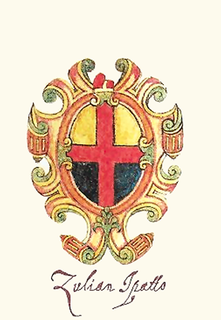 W
WTeodato Ipato was Doge of Venice from 742 to 755. With his election came the restoration of the dogato, which had been defunct since the assassination of his father, Orso Ipato. Before his election he had served as magister militum in 739.
 W
WFlavius Mar. Petrus Theodorus Valentinus Rusticius Boraides Germanus Iustinus, simply and commonly known as Justin, was an East Roman (Byzantine) aristocrat and general. A member of the Justinian Dynasty and nephew of Emperor Justinian I, he was appointed as one of the last Roman consuls in 540, before going on to assume senior military commands in the Balkans and in Lazica. He fought against the Slavs, the Sassanid Persians and supervised the Byzantine Empire's first contacts with the Avars. At the time of Justinian's death, he was seen as a probable successor, but was beaten to the throne by his cousin, Justin II, who exiled him to Egypt, where he was murdered.
 W
WMajorian was the western Roman emperor from 457 to 461. A prominent general of the Roman army, Majorian deposed Emperor Avitus in 457 and succeeded him. Majorian was the last emperor to make a concerted effort to restore the Western Roman Empire with its own forces. Possessing little more than Italy, Dalmatia, and some territory in northern Gaul, Majorian campaigned rigorously for three years against the Empire's enemies. His successors until the fall of the Empire, in 476/480, were actually instruments of their barbarian generals, or emperors chosen and controlled by the Eastern Roman court.
 W
WMarcellinus was a Roman general and patrician who ruled over the region of Dalmatia in the Western Roman Empire and held sway with the army there from 454 until his death.
 W
WMaurice was Byzantine emperor from 582 to 602. A prominent general, Maurice fought with success against the Sasanian Empire. After he became Emperor, he brought the war with Sasanian Persia to a victorious conclusion. Under him the Empire's eastern border in the South Caucasus was vastly expanded and, for the first time in nearly two centuries, the Romans were no longer obliged to pay the Persians thousands of pounds of gold annually for peace.
 W
WFlavius Odoacer, also spelled Odovacer or Odovacar, was a soldier and statesman of barbarian background, who deposed the child emperor Romulus Augustulus and became King of Italy (476–493). Odoacer's deposition of Romulus Augustulus is traditionally seen as marking the end of the Western Roman Empire as well as Ancient Rome.
 W
WFlavius Plinta was a Gothic politician and general of the Eastern Roman Empire. He held the title comes, and then became consul and magister militum praesentialis.
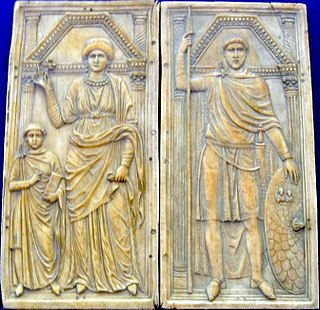 W
WFlavius Stilicho or Stilico was a military commander in the Roman army who, for a time, became the most powerful man in the Western Roman Empire. He was of Vandal origins and married to Serena, the niece of emperor Theodosius I, and became guardian for the underage Honorius. After many years of victories against a number of enemies, both barbarian and Roman, a series of political and military disasters finally allowed his enemies in the court of Honorius to remove him from power, culminating in his arrest and subsequent execution in 408.
 W
WTheodoric the Great, also called Theodoric the Amal, was king of the Ostrogoths (471–526), and ruler of the independent Ostrogothic Kingdom of Italy between 493–526, regent of the Visigoths (511–526), and a patrician of the East Roman Empire. As ruler of the combined Gothic realms, Theodoric controlled an empire stretching from the Atlantic Ocean to the Adriatic Sea. Though Theodoric himself only ever used the title 'king' (rex), some scholars characterize him as a Western Roman Emperor in all but name, since he ruled large parts of the former Western Roman Empire, had received the former Western imperial regalia from Constantinople in 497, and was referred to by the title augustus by some of his subjects.
 W
WFlavius Zeno was Eastern Roman emperor from 474 to 475 and again from 476 to 491. Domestic revolts and religious dissension plagued his reign, which nevertheless succeeded to some extent in foreign issues. His reign saw the end of the Western Roman Empire following the deposition of Romulus Augustus and the death of Julius Nepos, but he was credited with contributing much to stabilising the Eastern Empire.